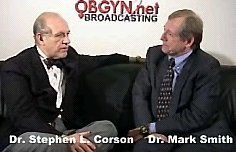Ablative Procedures of Endometrium
OBGYN.net Conference CoverageFrom American Association of Gynecological LaparoscopistsOrlando, Florida, November 2000

Audio/Video Link *requires RealPlayer - free download
Dr. Mark Smith: “Good morning, we’re fortunate to have with us Dr. Steve Corson. I think he’s been around the AAGL for so long that he doesn’t need much more of an introduction than that -Steve.”
Dr. Stephen L. Corson: “Mark, good morning.”
Dr. Mark Smith: “Thanks for joining us today.”
Dr. Stephen L. Corson: “Thank you.”
Dr. Mark Smith: “I’ve asked Steve to stop by, he’s done a lot of work in ablative procedures, and he’s working on some aspects of it. He has consented to give us kind of his take and overall view of the current state of ablative procedures of the endometrium. What’s going on, Steve?”
Dr. Stephen L. Corson: “If you let me pun a little bit, it’s a hot topic. The traditional methods of endometrial ablation expose the patient to the potential hazards of fluid intravasation, electrolyte abnormality, electrical mishaps, and certainly uterine perforation. So over the past ten years or so there has been considerable efforts spent in trying to bring this procedure into the office as what’s called a ‘global’ technique rather than a resectoscopic technique. Quite interestingly, the efforts have been rather diverse so that you have one method of ablation, which uses a thermal balloon through which hot liquid is passed and that would be the ThermaChoice, which is the one out on the market. Along the lines of hot liquid, you have the HydroThermAblator from BEI, which I’m intimate with, and that is a technique of hysteroscopy so it’s a direct view and not a blind view at very low pressure so that the hot saline does not exit the uterus through the tubes. You then have a system at the other end of the spectrum of cold - the cryogenesis system that uses an ice-ball to destroy endometrium. You have the Microsulis Corporation which has a microwave energy device which is inserted into the uterus and the energy is delivered by microwaves so there are a lot of different approaches to this but the goal which is common to all of them is a safe procedure, one which is as effective as the classical electrosurgical techniques, and something that can be accomplished under local anesthesia and maybe IV sedation. There’s a lot of excitement about this. The insurers are finally realizing that a well-performed endometrial ablation is a cost-effective alternative to hysterectomy.”
Dr. Mark Smith: “Following up on that, I was involved last year in talking to some insurance companies and they were quite amazed when we carried the data in on the difference of how effective it really was. I think the newer procedures tend to be much shorter and quicker. Remember the YAG ablation of the endometrium that used to take forever, these seem to go so much quickly.”
Dr. Stephen L. Corson: “The treatment times with the office procedures vary between four minutes and twenty minutes but, of course, for the surgeon, he or she doesn’t have to leave the office, go to the hospital, wait for the room to clear, change the clothes, do the case, and reverse the process. There’s also an office laser technique, which is being done in Europe using a dye laser that shows promise. There’s a bipolar technique from the Novasept folks that is very brief and is now in clinical trial in the United States. The ThermaChoice is the only one, which so far is FDA approved. The HydroThermAblator has currently finished the U.S. trials and that is under FDA consideration. The microwave device, which has been very popular in Europe and England, in particular, is currently in its FDA registration trial so there’s a lot of activity that by next year we should have a number of players on the market. For some people the balloon techniques, I think, will be fine, for other people who want to see what they’re doing, the hysteroscopic HTA affords them a view in real-time to see what’s going on. If you like and you’re from Minnesota and you’re used to being cold, you might like the cryogenic approach.”
Dr. Mark Smith: “Maybe they want the heat there.”
Dr. Stephen L. Corson: “But the results so far would indicate that we are on par with the resectoscopic techniques and everyone who’s done endometrial ablation will tell you that endometrial ablation is highly skilled intensive. You have to be a very good operative hysteroscopist to do this and, moreover, the uterus is not a level playing field, it has bumps and curves.”
Dr. Mark Smith: “And corners.”
Dr. Stephen L. Corson: “And corners and nooks and crannies, and it’s sometimes very difficult no matter how you’re doing this to make surface contact, that’s why the HTA is particularly intriguing because it utilizes a system of free flowing saline within 90 degrees centigrade within the uterine cavity so that it’s less skill intensive and you’re touching all the surfaces. That’s the one that is currently, as I said, at the FDA.”
Dr. Mark Smith: “I think by this time next year, as you mentioned, hopefully we’re going to have a lot more choices for our patients. We’ll have a lot more information on alternatives to hysterectomy on our side and ultimately it’s going to result in improved patient care. Thank you, Steve for coming by, we appreciate your time.”
Dr. Stephen L. Corson: “Thank you.”
*Editor's note - In addition to Dr. Corson's work at the Women's Institute for fertility, endocrinology and menopause, he is an investigator for BEI and the HydroThermAblator.
